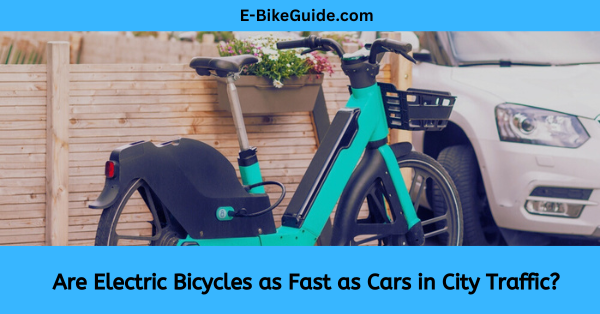Introduction
In recent years, urban transportation has witnessed a revolutionary shift with the advent of electric bicycles, commonly known as e-bikes. As cities become increasingly congested, the question arises: Are electric bicycles as fast as cars in city traffic? This guide delves into the dynamics of city traffic, the capabilities of e-bikes, and how they compare to traditional automobiles in urban environments.
Understanding Urban Traffic Dynamics

City Traffic: A Complex Ecosystem
City traffic is characterized by high density, frequent stops, and diverse vehicle types. Congestion, traffic lights, pedestrian crossings, and construction zones all contribute to the overall traffic flow. During peak hours, traffic can slow to a crawl, making alternative transportation modes like e-bikes an appealing option.
Factors Affecting Urban Traffic Flow
Several factors influence urban traffic, including:
- Population Density: Higher population density leads to more vehicles on the road.
- Infrastructure: The design and capacity of roads, bike lanes, and public transit systems.
- Traffic Regulations: Speed limits, traffic signals, and pedestrian zones.
- Public Transportation Options: Availability and efficiency of buses, subways, and trams.
The Rise of Electric Bicycles

What Are Electric Bicycles?
Electric bicycles, or e-bikes, are bicycles equipped with an electric motor that assists with pedaling. They come in various styles, including commuter bikes, mountain bikes, and folding bikes, catering to different urban needs.
Types of E-Bikes
There are three main types of e-bikes:
- Pedal-Assist E-Bikes: The motor only activates when the rider pedals, providing a boost.
- Throttle-Controlled E-Bikes: The motor can propel the bike without pedaling.
- Speed Pedelecs: These high-performance e-bikes can reach higher speeds and often require registration and insurance.
Advantages of E-Bikes in Urban Areas
E-bikes offer numerous benefits for city dwellers:
- Efficiency: E-bikes can navigate through traffic more easily than cars.
- Cost-Effective: Lower operating costs compared to cars.
- Environmentally Friendly: Reduced emissions and less reliance on fossil fuels.
- Health Benefits: Encourages physical activity, albeit with motor assistance.
Comparing Speed: E-Bikes vs. Cars

Speed Limits and Regulations
E-bikes are subject to different speed regulations depending on the region. In most places, pedal-assist e-bikes are limited to 20 mph, while speed pedelecs can go up to 28 mph. Cars, on the other hand, are subject to varying speed limits, typically between 25-35 mph in urban areas.
Real-World Traffic Conditions
In real-world traffic, cars are often hindered by congestion, traffic lights, and parking issues. E-bikes, however, can take advantage of bike lanes, shortcuts, and the ability to bypass traffic jams.
Acceleration and Manoeuvrability
E-bikes excel in stop-and-go traffic due to their quick acceleration and nimbleness. Cars, while faster on open roads, struggle with frequent stops and tight spaces.
Case Studies and Real-Life Examples

Case Study 1: New York City
In New York City, where traffic congestion is notorious, e-bikes have become a popular alternative. Riders often report faster commute times compared to cars, especially during peak hours. Bike lanes and dedicated cycling paths further enhance their appeal.
Case Study 2: Amsterdam
Amsterdam, known for its cycling culture, sees a significant number of e-bikes on the road. The city’s extensive network of bike lanes allows e-bikes to move swiftly, often outpacing cars during rush hour.
Case Study 3: San Francisco
San Francisco’s hilly terrain poses a challenge for traditional bicycles. E-bikes, with their motor assistance, make it easier to tackle inclines, making them a preferred choice for many commuters.
Environmental Impact

Reduced Carbon Footprint
E-bikes produce significantly lower emissions compared to cars. This reduction in carbon footprint is crucial for combating climate change and improving urban air quality.
Energy Efficiency
E-bikes are more energy-efficient than cars, requiring less energy per mile traveled. This efficiency translates to lower fuel costs and less environmental impact.
Health and Wellness Benefits

Physical Activity
While e-bikes provide motor assistance, they still require pedaling, promoting physical activity. Regular use can improve cardiovascular health and overall fitness.
Mental Well-Being
Cycling, even with assistance, can reduce stress levels and enhance mental well-being. The freedom and flexibility of e-bike commuting contribute to a more relaxed and enjoyable travel experience.
Economic Considerations

Cost of Ownership
E-bikes have a lower cost of ownership compared to cars. They require less maintenance, no fuel, and have fewer associated costs like insurance and parking fees.
Government Incentives
Many governments offer incentives for e-bike purchases, including tax credits and subsidies. These incentives make e-bikes an even more attractive option for urban commuters.
Safety Concerns and Precautions
Traffic Safety
Safety is a primary concern for e-bike riders. Wearing helmets, using lights, and adhering to traffic laws are essential for safe riding.
Infrastructure Improvements
Cities need to invest in cycling infrastructure to ensure the safety of e-bike riders. This includes dedicated bike lanes, secure parking, and clear signage.
Rider Education
Educating riders on safe practices and road etiquette is crucial. Proper training can significantly reduce the risk of accidents.
Technological Innovations

Battery Technology
Advancements in battery technology have led to longer-lasting and more efficient e-bike batteries. This improvement enhances the practicality of e-bikes for daily commuting.
Smart Features
Modern e-bikes come equipped with smart features like GPS, connectivity with smartphones, and advanced security systems. These features make e-bikes more user-friendly and secure.
Future Trends
The e-bike industry is rapidly evolving, with continuous innovations aimed at improving performance, safety, and user experience. Future trends include integration with smart city infrastructure and further advancements in battery technology.
Conclusion

In conclusion, electric bicycles offer a viable and often faster alternative to cars in city traffic. Their ability to navigate through congestion, use bike lanes, and provide quick acceleration makes them a practical choice for urban commuting. With environmental, economic, and health benefits, e-bikes are set to play a significant role in the future of urban transportation. As cities continue to evolve, embracing e-bikes could lead to more efficient, sustainable, and enjoyable urban mobility.
FAQs
1. How fast can an electric bicycle go?
Electric bicycles typically have a top speed of 20 mph for pedal-assist models and up to 28 mph for speed pedelecs. The actual speed can vary based on local regulations and the specific model of the e-bike.
2. Are e-bikes safe to use in heavy traffic?
E-bikes can be safe in heavy traffic if riders follow safety guidelines such as wearing helmets, using lights, and adhering to traffic laws. Proper infrastructure like dedicated bike lanes also enhances safety.
3. Do I need a license to ride an e-bike?
In many regions, pedal-assist e-bikes do not require a license. However, speed pedelecs and throttle-controlled e-bikes may require registration and insurance. It is important to check local regulations.
4. How long does an e-bike battery last?
The lifespan of an e-bike battery depends on the type and usage. On average, a well-maintained battery can last between 3 to 5 years. Regular charging and proper storage can extend battery life.
5. Can e-bikes handle hills and inclines?
Yes, e-bikes are well-suited for hills and inclines thanks to their motor assistance. They provide a significant boost to the rider’s pedaling power, making it easier to climb steep terrain.
